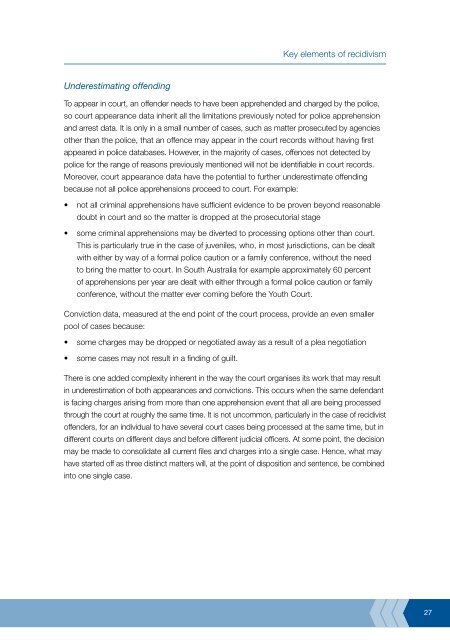Recidivism in Australia : findings and future research - Australian ...
Recidivism in Australia : findings and future research - Australian ...
Recidivism in Australia : findings and future research - Australian ...
You also want an ePaper? Increase the reach of your titles
YUMPU automatically turns print PDFs into web optimized ePapers that Google loves.
Underestimat<strong>in</strong>g offend<strong>in</strong>g<br />
To appear <strong>in</strong> court, an offender needs to have been apprehended <strong>and</strong> charged by the police,<br />
so court appearance data <strong>in</strong>herit all the limitations previously noted for police apprehension<br />
<strong>and</strong> arrest data. It is only <strong>in</strong> a small number of cases, such as matter prosecuted by agencies<br />
other than the police, that an offence may appear <strong>in</strong> the court records without hav<strong>in</strong>g first<br />
appeared <strong>in</strong> police databases. However, <strong>in</strong> the majority of cases, offences not detected by<br />
police for the range of reasons previously mentioned will not be identifiable <strong>in</strong> court records.<br />
Moreover, court appearance data have the potential to further underestimate offend<strong>in</strong>g<br />
because not all police apprehensions proceed to court. For example:<br />
•<br />
•<br />
not all crim<strong>in</strong>al apprehensions have sufficient evidence to be proven beyond reasonable<br />
doubt <strong>in</strong> court <strong>and</strong> so the matter is dropped at the prosecutorial stage<br />
some crim<strong>in</strong>al apprehensions may be diverted to process<strong>in</strong>g options other than court.<br />
This is particularly true <strong>in</strong> the case of juveniles, who, <strong>in</strong> most jurisdictions, can be dealt<br />
with either by way of a formal police caution or a family conference, without the need<br />
to br<strong>in</strong>g the matter to court. In South <strong>Australia</strong> for example approximately 60 percent<br />
of apprehensions per year are dealt with either through a formal police caution or family<br />
conference, without the matter ever com<strong>in</strong>g before the Youth Court.<br />
Conviction data, measured at the end po<strong>in</strong>t of the court process, provide an even smaller<br />
pool of cases because:<br />
•<br />
•<br />
some charges may be dropped or negotiated away as a result of a plea negotiation<br />
some cases may not result <strong>in</strong> a f<strong>in</strong>d<strong>in</strong>g of guilt.<br />
Key elements of recidivism<br />
There is one added complexity <strong>in</strong>herent <strong>in</strong> the way the court organises its work that may result<br />
<strong>in</strong> underestimation of both appearances <strong>and</strong> convictions. This occurs when the same defendant<br />
is fac<strong>in</strong>g charges aris<strong>in</strong>g from more than one apprehension event that all are be<strong>in</strong>g processed<br />
through the court at roughly the same time. It is not uncommon, particularly <strong>in</strong> the case of recidivist<br />
offenders, for an <strong>in</strong>dividual to have several court cases be<strong>in</strong>g processed at the same time, but <strong>in</strong><br />
different courts on different days <strong>and</strong> before different judicial officers. At some po<strong>in</strong>t, the decision<br />
may be made to consolidate all current files <strong>and</strong> charges <strong>in</strong>to a s<strong>in</strong>gle case. Hence, what may<br />
have started off as three dist<strong>in</strong>ct matters will, at the po<strong>in</strong>t of disposition <strong>and</strong> sentence, be comb<strong>in</strong>ed<br />
<strong>in</strong>to one s<strong>in</strong>gle case.<br />
27















